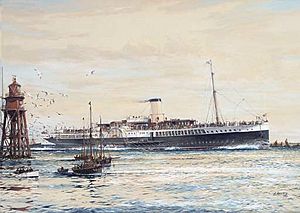HMS Crested Eagle facts for kids
 |
|
Quick facts for kids History |
|
|---|---|
| United Kingdom | |
| Name | Crested Eagle |
| Owner | General Steam Navigation Co |
| Operator | |
| Port of registry | |
| Builder | J. Samuel White, East Cowes |
| Launched | 25 March 1925 |
| Completed | June 1925 |
| Identification | |
| Fate | Bombed and beached, 1940 |
| General characteristics as built | |
| Type | Paddle steamer |
| Tonnage | 1,110 GRT, 579 NRT |
| Length | 229.7 ft (70.0 m) |
| Beam | 34.6 ft (10.5 m) |
| Depth | 11.1 ft (3.4 m) |
| Installed power | 538 NHP |
| Propulsion | triple-expansion engines |
The HMS Crested Eagle was a special type of ship called a paddle steamer. It was built in 1925 and became famous for its role in the Dunkirk evacuation during World War II. This ship was originally a passenger vessel. But it was later used by the Royal Navy to help defend against enemy planes.
Contents
Ship's Early Life and Design
The Crested Eagle was built by J. Samuel White in 1925. It was a very modern ship for its time. It was the first paddle steamer on the River Thames to use oil for fuel.
Special Features for London Bridge
The ship had some clever features. It had a special funnel that could be made shorter. Its mast could also be folded down. This design allowed the Crested Eagle to pass easily under London Bridge. This meant it could pick up passengers from Old Swan Pier, very close to the bridge.
Passenger Routes
The Crested Eagle usually carried passengers. It sailed from London along the Thames to places like Margate. Later, in 1932, it started new routes. These routes went from London to Clacton-on-Sea and Felixstowe.
World War II Service
When World War II began in September 1939, the Crested Eagle was called into action. It helped with a very important job. The ship was used to evacuate children from London. It carried them safely to Felixstowe, away from the city.
Role in the Dunkirk Evacuation
On May 29, 1940, the Crested Eagle played a brave part in the Dunkirk evacuation. This was a huge rescue mission. Many Allied soldiers were trapped on the beaches of Dunkirk, France. The ship, led by Lieutenant Commander Bernard Booth, sailed to the east mole (a long pier) at Dunkirk.
Under Attack at Dunkirk
While at the mole, soldiers were quickly boarding ships. The area was under constant attack from bombs. Two other ships, the HMS Grenade and SS Fenella, were hit and damaged. The brave survivors from these ships then boarded the Crested Eagle.
The Sinking of Crested Eagle
With about 600 men on board, the Crested Eagle began to leave Dunkirk. But less than a mile from the mole, it was hit by several bombs. The back of the ship caught fire. Many soldiers were sheltering in the lounges, which were now burning. The captain was told the ship could not be saved. He ordered the ship to be run aground on the beach.
Rescue and Aftermath
About 200 survivors from the Crested Eagle were rescued by other ships. These included HMS Albury, HMS Lydd, and TSS St Seiriol. Sadly, many soldiers lost their lives during this attack. The Crested Eagle's second engineer and a stoker from the Grenade were also saved from the water.
Current Location
Today, the remains of the Crested Eagle can still be seen. At low tide, parts of the ship are visible on Zuydcoote beach in France.
Images for kids




